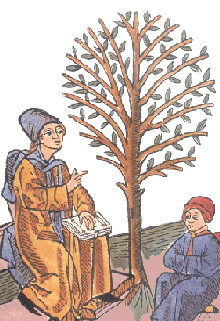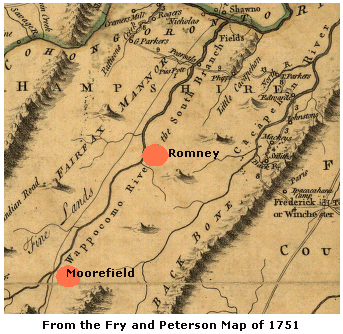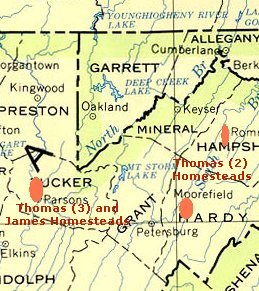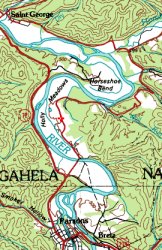
|
Illuminations, Epiphanies, & Reflections
Family Trees
The
Parsons
Thomas (2) Parsons, 1688-1772
Although it is clear that Thomas (2) Parsons left Bucks County sometime
after the death of his father in 1721, it is unknown when he left and
it is unknown where he went. A Parsons history and several
Parsons family trees imply that he traveled directly to Hampshire
County, Virginia, where he married his wife Parthenia Baldwin in
1729. However, it is likely that Thomas (2) spent some years in
western Pennsylvania before moving on to Virginia. In fact,
Hampshire County did not even exist until 1753 when it was created from
Frederick County by the General Assembly of Virginia.
Additionally, the Parsons are not listed in any legal or historical
document as one of the region's nine earliest families that settled in
the area between 1725 and 1740. That said, it is possible Thomas
(2) had arrived in the area by 1748 for by that time over 200 people
lived in and around the town of Pearsall's Flats, later renamed Romney, however the first
legal or historical document in which his name appears is dated 1761.
Many of these 200 pioneers from Pennsylvania had traveled to area via
the "Great Philadelphia Wagon Road," which went west from Philadelphia,
joined with the "Great Valley Road" through the northern Shenandoah
Valley. At Winchester, they turned westward once again via what
would come to be known as the "Old Northwestern Turnpike" and entered
what would become Hampshire County. It is highly likely that
Thomas (2) followed this route west, and it is highly likely that he
stopped and lived for sometime at some point along the route.
When reports of the numerous settlers around Pearsall's Flats reached
Lord Thomas Fairfax, the owner of the land,
he realized that he was sitting on a potential goldmine. Lord
Fairfax, who had seen much of his family fortune depleted in England,
had inherited the land between the Rappahannock and Potomac Rivers,
including what is now western Virginia and West Virginia, from his
mother. So he moved to the colony and settled in Winchester in
1735 to live upon and watch over his domain. By 1748, Lord
Fairfax understood there was considerable money to be made by selling
his western lands to new settlers, which would also provide a buffer
between Winchester and the French and their Native American
allies. So, he hired James Glenn, the only certified surveyor in Virginia, and a team of six
assistants, including 16-year old George Washington, to survey the region and
lay-off plots for sales or rentals, not just to
the current occupants, but for the scores of pioneers who were arriving on a regular basis
from Pennsylvania. Whether or not Thomas (2) bought his property directly from Lord Fairfax, he held
sizeable tracks of land along the South Branch of the Potomac River by
end of the 1750s, the most significant being in the vicinity of the
towns of Romney and Moorefield. and a team of six
assistants, including 16-year old George Washington, to survey the region and
lay-off plots for sales or rentals, not just to
the current occupants, but for the scores of pioneers who were arriving on a regular basis
from Pennsylvania. Whether or not Thomas (2) bought his property directly from Lord Fairfax, he held
sizeable tracks of land along the South Branch of the Potomac River by
end of the 1750s, the most significant being in the vicinity of the
towns of Romney and Moorefield.
For
some time, the French had been instigating their Native American allies
against the English and war parties routinely attacked rural
homesteads. When open hostilities finally broke out with the
French and Indian War in 1753, life in Hampshire County became perilous
as the raids increased in both frequency and ferocity.
Even after the war officially ended, the Delaware and Shawnee continued
to launch murderous raids on homesteads and settlements throughout the
region until they were finally defeated by the British Army at Bushy
Run in western Pennsylvania.
 Before that occurred,
however, a young man
named Thomas Howell, thought by some to be
an adopted son of Thomas
(2), was captured by the Indians, possibly in 1762, and taken as a
slave to lands on the other side of the Ohio River. Nine years
later, Howell managed to escape from his captors and blaze a trail back
to Moorefield. There he described to Thomas (2) Parsons and his
two sons, Thomas (3) and James, not only his adventure, but the
excellent lands along the Cheat River that
he found on his journey
home. Together they decided to retrace Howell's trail and claim
the western land. Unfortunately, Howell and Thomas (2) died
before the trip could be made, but Thomas (3) and James explored and
claimed the region in 1772 and established homesteads in 1774 between
the present day towns of St. George and Parsons. Before that occurred,
however, a young man
named Thomas Howell, thought by some to be
an adopted son of Thomas
(2), was captured by the Indians, possibly in 1762, and taken as a
slave to lands on the other side of the Ohio River. Nine years
later, Howell managed to escape from his captors and blaze a trail back
to Moorefield. There he described to Thomas (2) Parsons and his
two sons, Thomas (3) and James, not only his adventure, but the
excellent lands along the Cheat River that
he found on his journey
home. Together they decided to retrace Howell's trail and claim
the western land. Unfortunately, Howell and Thomas (2) died
before the trip could be made, but Thomas (3) and James explored and
claimed the region in 1772 and established homesteads in 1774 between
the present day towns of St. George and Parsons.
Also in 1774, another pioneer named John Minear, possibly at the
invitation of James Parsons, led about a
dozen
families into the area. They had no sooner begun to establish
homesteads when Lord Dunmore's War broke out, and
they chose to abandon the area. Although, all of the land that now comprises West
Virginia was sold to Virginia by the Iroquois Confederacy in 1768, the
Shawnee's, who had become familiar with the region during the French
and Indian War, placed designs upon it and attempted to prevent new
settlers and drive out the existing settlements. Two years later,
after the war ended in 1776, the Minear party returned to restart their
"colony," and initiated a land dispute with
the Parsons. In the end, the Parsons were granted almost all of
their original claim with James' living in the land in-and-around
Horseshoe Bend and Thomas owning the land in-and-around Holly Meadows;
the Minear group settled closer to what today is St. George.
the area. Although, all of the land that now comprises West
Virginia was sold to Virginia by the Iroquois Confederacy in 1768, the
Shawnee's, who had become familiar with the region during the French
and Indian War, placed designs upon it and attempted to prevent new
settlers and drive out the existing settlements. Two years later,
after the war ended in 1776, the Minear party returned to restart their
"colony," and initiated a land dispute with
the Parsons. In the end, the Parsons were granted almost all of
their original claim with James' living in the land in-and-around
Horseshoe Bend and Thomas owning the land in-and-around Holly Meadows;
the Minear group settled closer to what today is St. George.
|
|
|
|

